Day 1 of a three day Autumn Migration & Wader Spectacular tour. After a cloudy start, it gradually brightened up and was hot and sunny by the middle of the day. It was forecast to stay mostly dry today, but it didn’t – it then clouded over through the afternoon and a band of rain moved in. The most reliable thing about the weather forecast is that it is very often wrong! Thankfully we had already enjoyed a good day by that stage.
Our first destination for the morning was Cley. A Common Buzzard was circling out over the grazing marsh as we got out of the minibus. Walsey Hills can be good if there are migrants arriving, so we went in for a quick look first thing to see if anything had come in overnight. A Cetti’s Warbler was practicing singing ahead of us deep in the bushes.
There were lots of Goldfinches around the feeders, and one or two Greenfinches with them. A succession of Blue Tits and Great Tits came in too. Further in, a Blackcap flicked up briefly in the top of a large hawthorn and we stopped briefly to admire the Ivy Bees buzzing around the ivy flowers by the path. There were lots of Chiffchaffs flicking in and out of the willows at the back, but no sign of anything more unusual in here today.
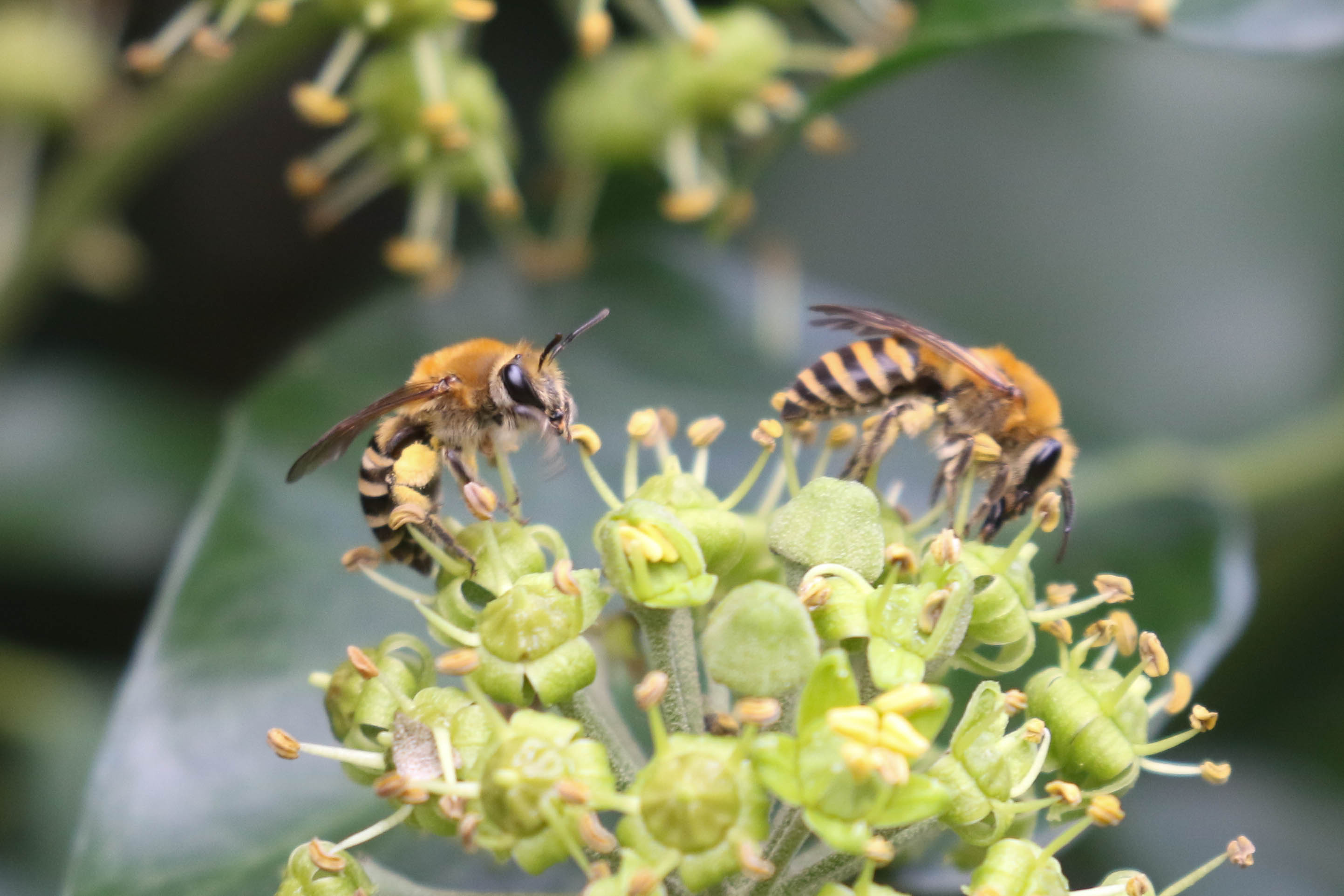
We continued along the path just out beyond the bushes and into the fields beyond. Three Red-legged Partridges flew up out of the stubble, and several Pheasants erupted from the other side of the fenceline. The shooting season is upon us again! We could see some distant Woodpigeons on the wires and one smaller bird with them, a single Stock Dove. Through the scope, we could see it lacked a white collar and had dark spots on its wings.
Back out, we crossed the road and made our way over to the East Bank. A Marsh Harrier was hanging in the air distantly over the reedbed. There were three Little Grebes on Don’s Pool this morning, but all adults and no sign of the small stripy juveniles we have been watching here recently. The pair were diving together but there was no sign of them hurrying to feed anything. Two down to zero already?
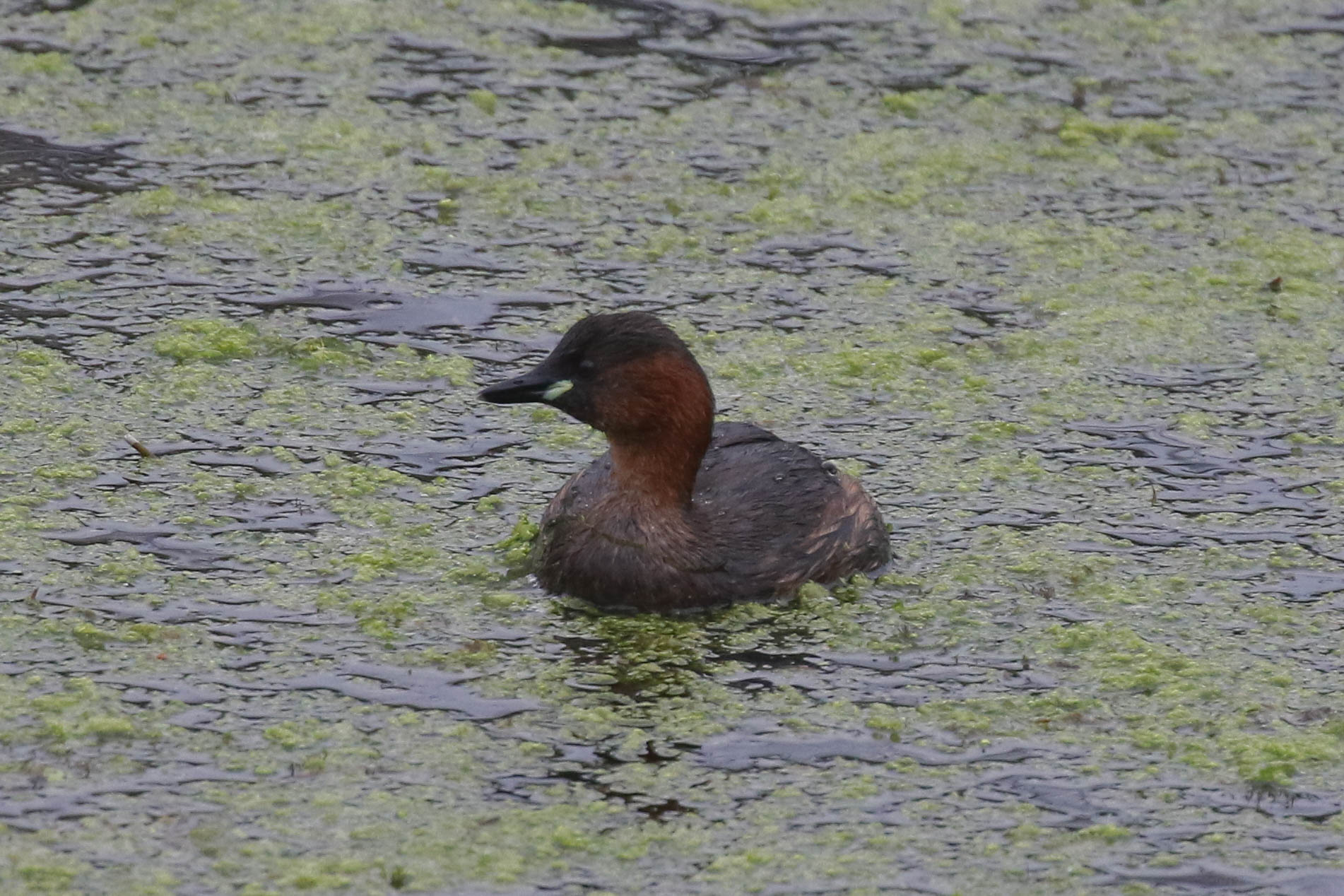
A little further on, we stopped to scan the grazing marsh the other side. There were lots of brown ducks hiding in the grass, mostly eclipse drake Mallards, and a nice selection of Wigeon, Teal and Shoveler further back on the edge of the pool – again all the drakes are currently in their duller eclipse plumage. There were plenty of Greylags too and a flock of Canada Geese flew over the reeds further back presumably heading inland to feed on the stubble fields.
We could see several Lapwings and Curlews in the grass with the ducks. Further back, on Pope’s Pool, there were lots of Black-tailed Godwits and a four Avocets.
On the near end of the Serpentine, there were more Teal and three juvenile Shelduck. A few Pied Wagtails were chasing round on the short grass. Three Black-tailed Godwits were all rusty juvenile Icelandic birds – it looks like it might have been a good breeding season for them this year?
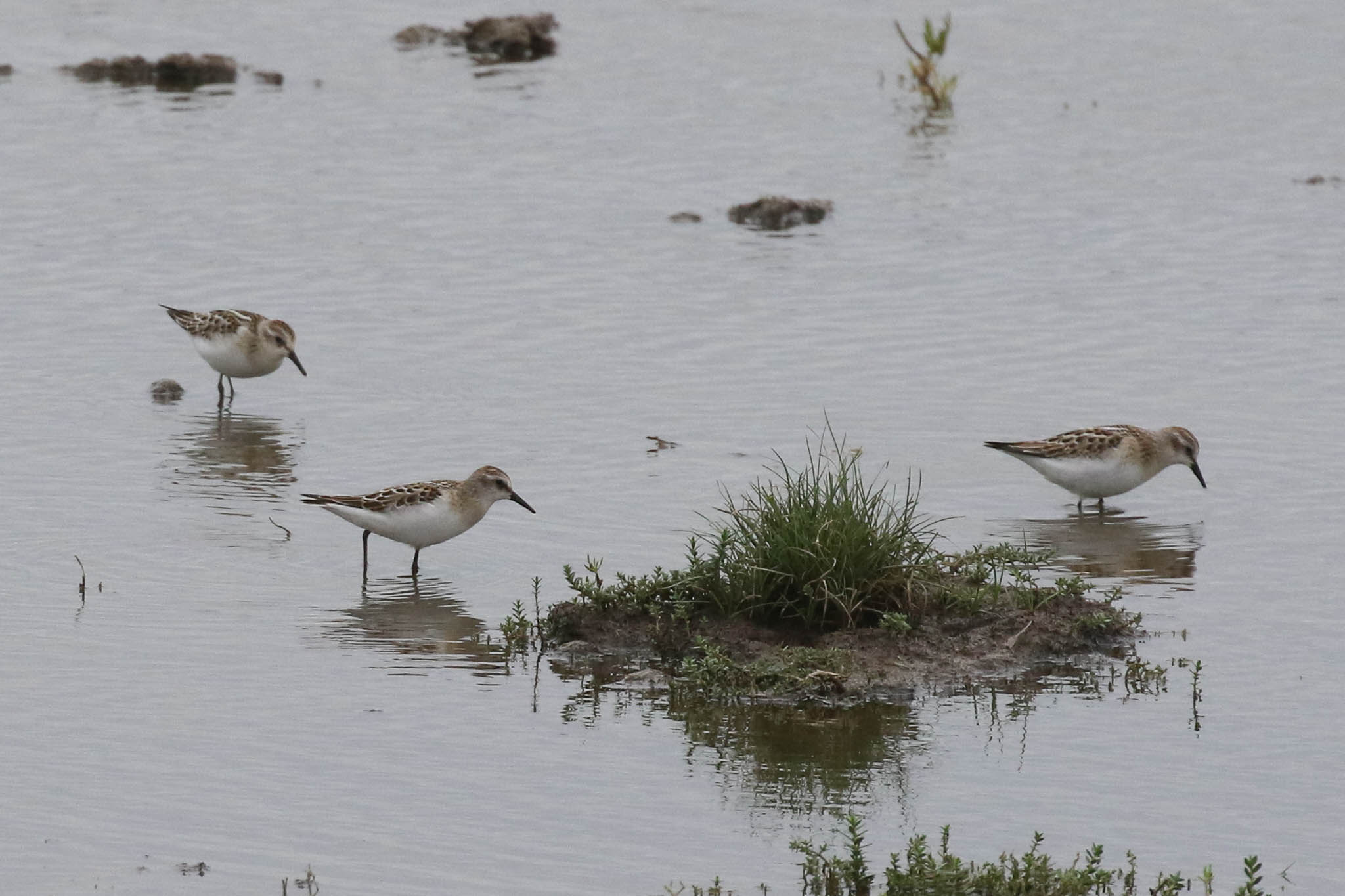
Further up, we could see a group of small waders in the north-west corner, so we walked up for a closer look. Three juvenile Dunlin were picking around in the shallow water with three juvenile Little Stints, very close to the bank. We had a very nice view of them through the scope, a good size comparison with the two species side by side – Dunlin is already a small wader, but the Little Stints were only about 2/3 the size!
A juvenile Little Ringed Plover was lurking on the mud down in the vegetation at the front too. Through the scope, we could see the ghosting of the pale eye ring which will be golden yellow when it is an adult. A Common Snipe was even better hidden, asleep in the longer grass behind. We could hear Bearded Tits calling on and off behind us, but despite regular turning round to scan, there was no sign of them emerging from the reeds. It was perhaps a bit breezy here this morning.
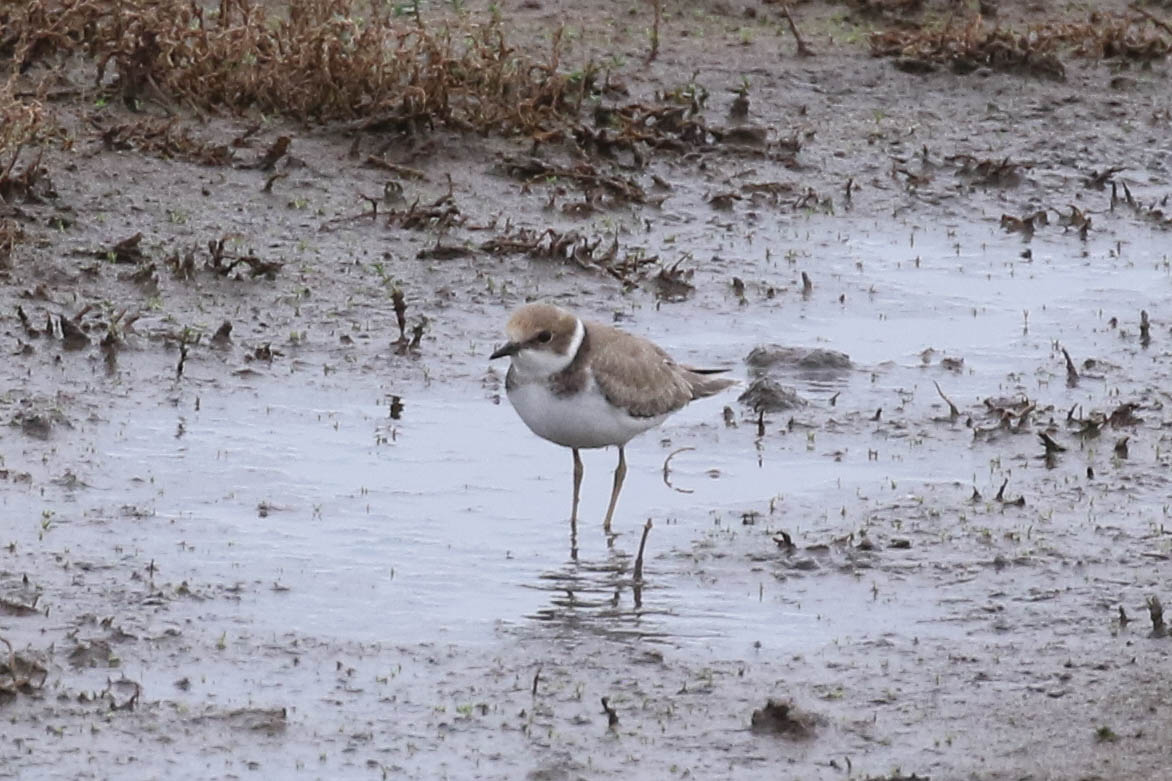
Continuing on to Arnold’s Marsh, there were four Sandwich Terns out on the small shingle islands. We got the scope on them and admired their yellow-tipped black bills and shaggy crests. There were plenty of Redshank feeding in the water and lots of Dunlin roosting on here today, asleep on the shingle islands and hiding in vegetation at back, probably pushed out of Blakeney Harbour by big spring tide. We couldn’t find any sign of the Curlew Sandpipers which had been reported here earlier, but they could easily have been lurking in the vegetation too, out of view.
A Wheatear flicked out onto the sand right at the back, but disappeared almost immediately into the samphire before anyone could get onto it. A huge flock of Meadow Pipits flushed from the grass at the back and flew round calling.
Out at the beach, the sea was flat calm today. It looked quiet, but the more we scanned the more we found. A distant Red-throated Diver flew east and a small flock of Common Scoter flew past along the horizon. Three Gannets, an adult and two juveniles, circled out over the sea before continuing on east.
Five Mediterranean Gulls, all 1st winters, were bobbing on the sea to the east of us – we had a look at them in the scope before they took off and flew past. Then we noticed a larger gull coming in off the sea in the distance to the west. It landed on the beach with a couple of Herring Gulls towards Coastguards and through the scope, we confirmed out suspicions – it was a 1st calendar year Caspian Gull (moulting from juvenile to 1st winter). It lingered just long enough for everyone to have a look through the scope, before it disappeared off to the west.
Suddenly several Sandwich Terns started calling and diving down to the sea a short distance to the east. We looked over to see fish jumping out of the water around them – something was obviously attacking the bait from below. Any gulls in the vicinity immediately flew in to join them and two Common Terns appeared, a juvenile begging from the adult ahead of it.
While we were enjoying the action out to sea, we heard a Raven kronking behind us. We turned round to see two flying over the East Bank and out over Arnold’s. A scarce bird here, they are on the increase but still a delight to see and hear.
As we turned to walk back, we could see all the Dunlin flying round on Arnold’s, so we stopped in the shelter for another look. Unfortunately they had landed and gone straight back to sleep and there was still no sign of any Curlew Sandpipers. However, the stop here did produce a Hobby perched on one of the posts at the back.
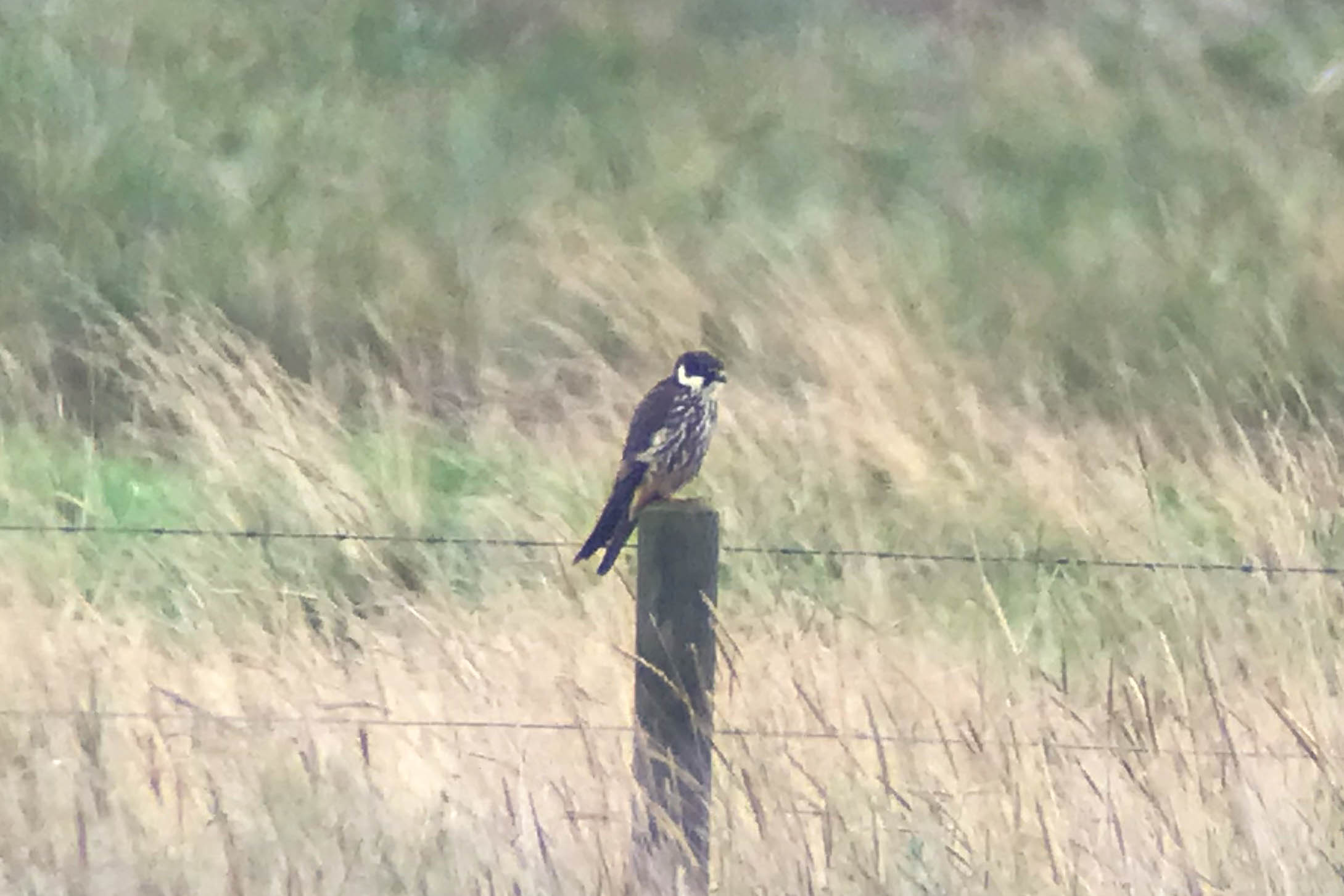
The Little Stints were still showing well on the Serpentine and there were two Little Ringed Plovers now, both juveniles. Two winter adult Black-tailed Godwits had joined the three juveniles. The Bearded Tits were calling again, but this time we turned round to see four fly up out of the reeds. They landed and disappeared in, but then a male shuffled up to the top of a reed stem. Unfortunately it didn’t stay long, and they were all off again flying away over the reeds.
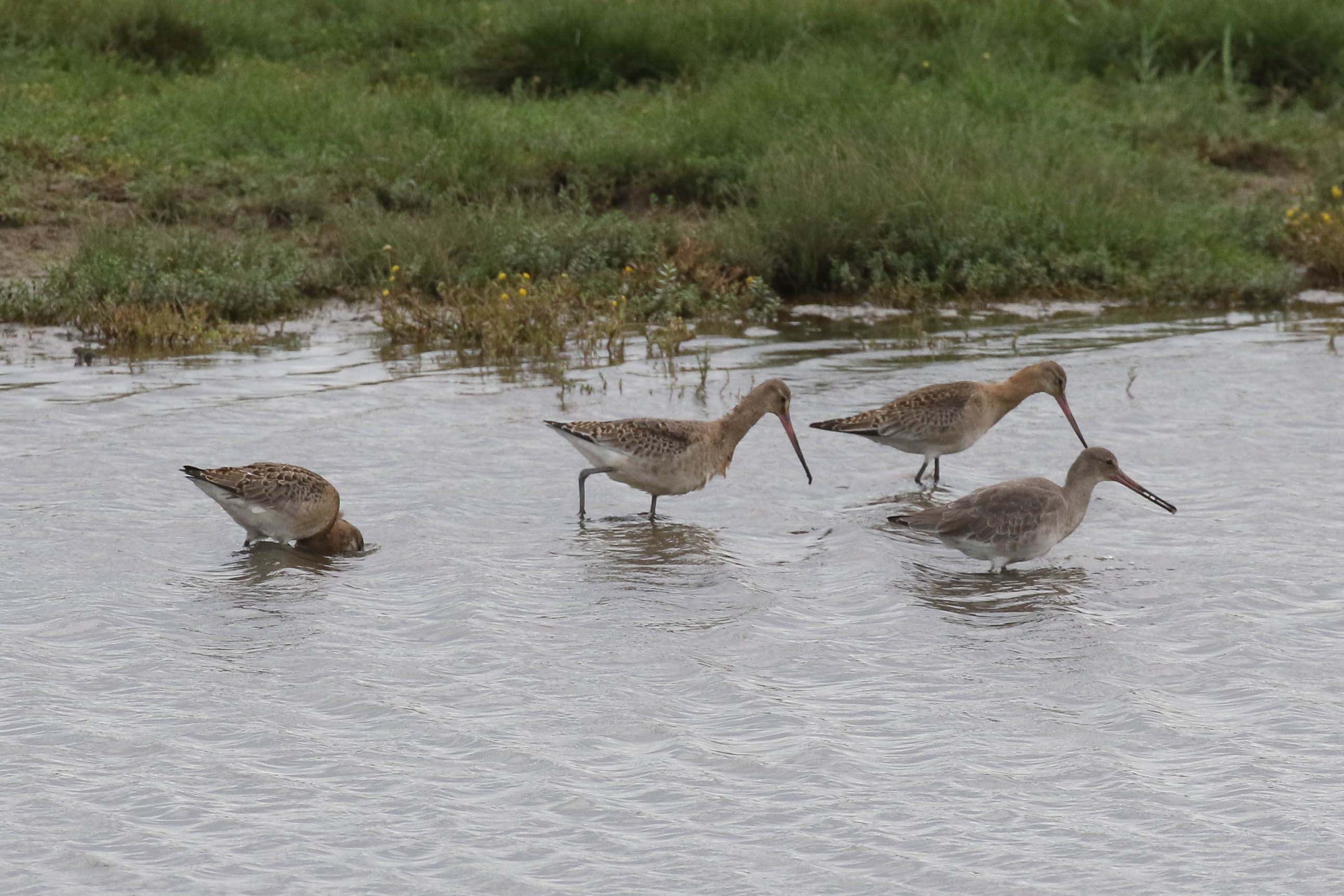
Back at the minibus, we had a quick look at Snipe’s Marsh. There were lots of birds flitting in and out of the reeds at the back, dropping down to feed on the mud – several Blue Tits, lots of Chiffchaffs, and a single Reed Warbler with them.
We still had a little bit of time before lunch, so we drove round to Cley Coastguards. We thought we would would walk down towards North Scrape to have a quick look for any chats around the Eye Field and in the weedy grass behind the beach, but it was rather quiet here today. We did flush a couple of Skylarks though, which were an addition to the day’s list.
We stopped to scan from the ridge at the top of the Eye Field. A flock of Dunlin flew in and landed on North Scrape, and through the scope we could see a Little Stint in with them. They didn’t linger long and we watched them fly off west past us, over the Eye Field. A Common Buzzard was perched on a post in the middle of the grazing marsh and we looked up to see several more circling up behind. It was warming up nicely now.
We couldn’t see anything else, so we decided to head back and round to the Visitor Centre for lunch in the sunshine. Looking out from the picnic area, we could see a Marsh Harrier quartering over the back of the reserve, flushing all the Rooks up out of the grass.
After lunch, we drove east to Kelling village and took the track down towards the Water Meadow. A couple of Migrant Hawker dragonflies hawked up and down the hedges and a Comma butterfly landed with its wings closed showing off its white comma mark.
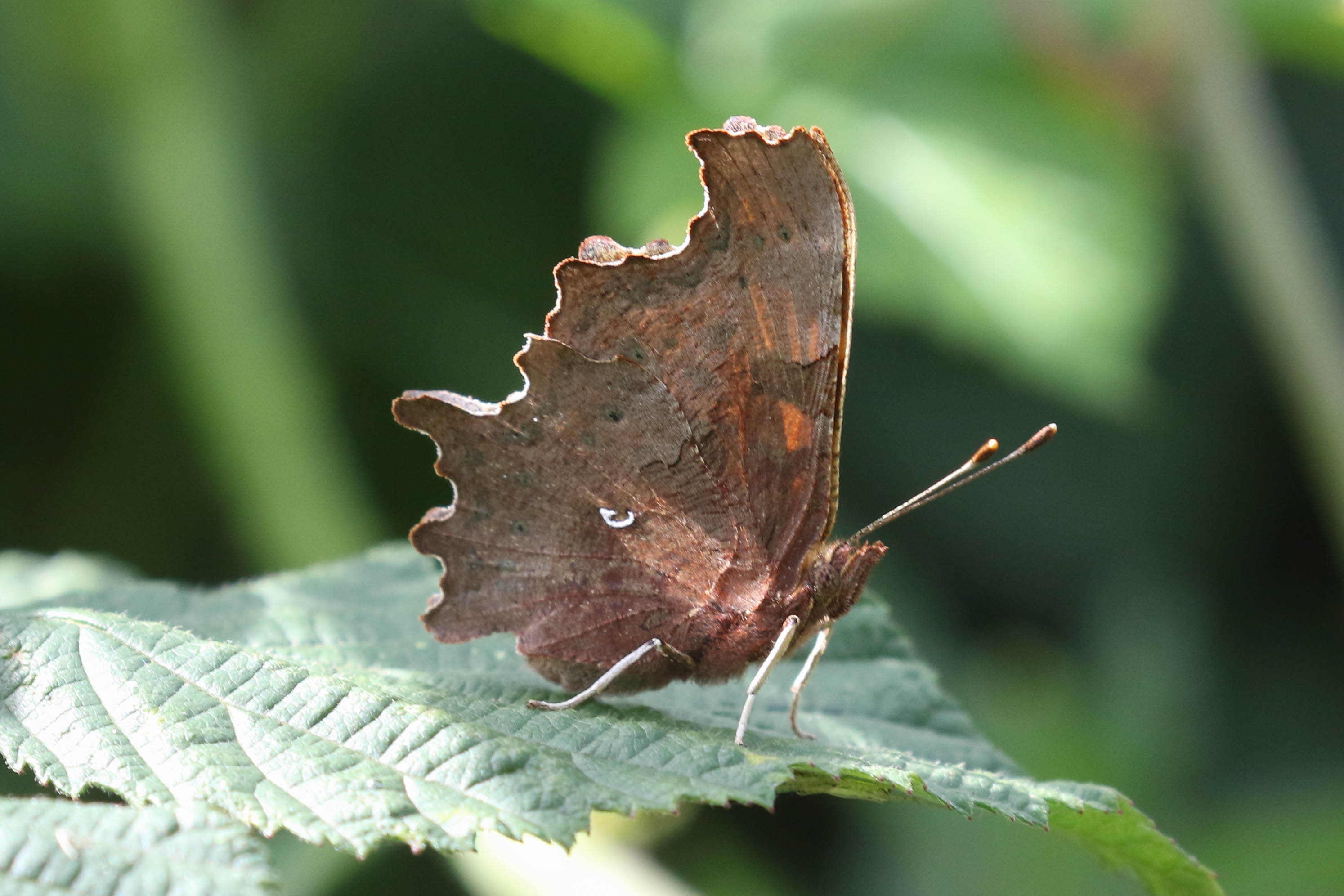
We had a quick look from the gate beyond the copse – the hillside beyond the Water Meadow was full of Rooks – but we were on a mission so we didn’t linger here. We were told on the way down that the Barred Warbler had been showing and there were a few people standing further down the track, looking over the fence through a gap in the brambles.
The Barred Warbler had been very difficult to see yesterday – they can be very skulking – but we figured it was worth a quick look to try our luck. We stopped where the others were standing but there wasn’t enough room for all of us to see through the small gap, so we walked on and down to the gate at the far end, on the cross-track. There was more room here and we could all look back at the bush where the Barred Warbler was hiding. We hadn’t been there more than a minute when it appeared on the edge of the bush!
We got the Barred Warbler in the scope and everyone got a look at it before it disappeared back in. The pressure was off now, but we didn’t have to wait long before it came out again and starting eating berries. A 1st winter, it lacked the heavy barring below of adults but did have some scalloping on the flanks and under tail. A scarce drift migrant from the continent, it had originally turned up here yesterday, so it was nice that it had hung around for us to see it.
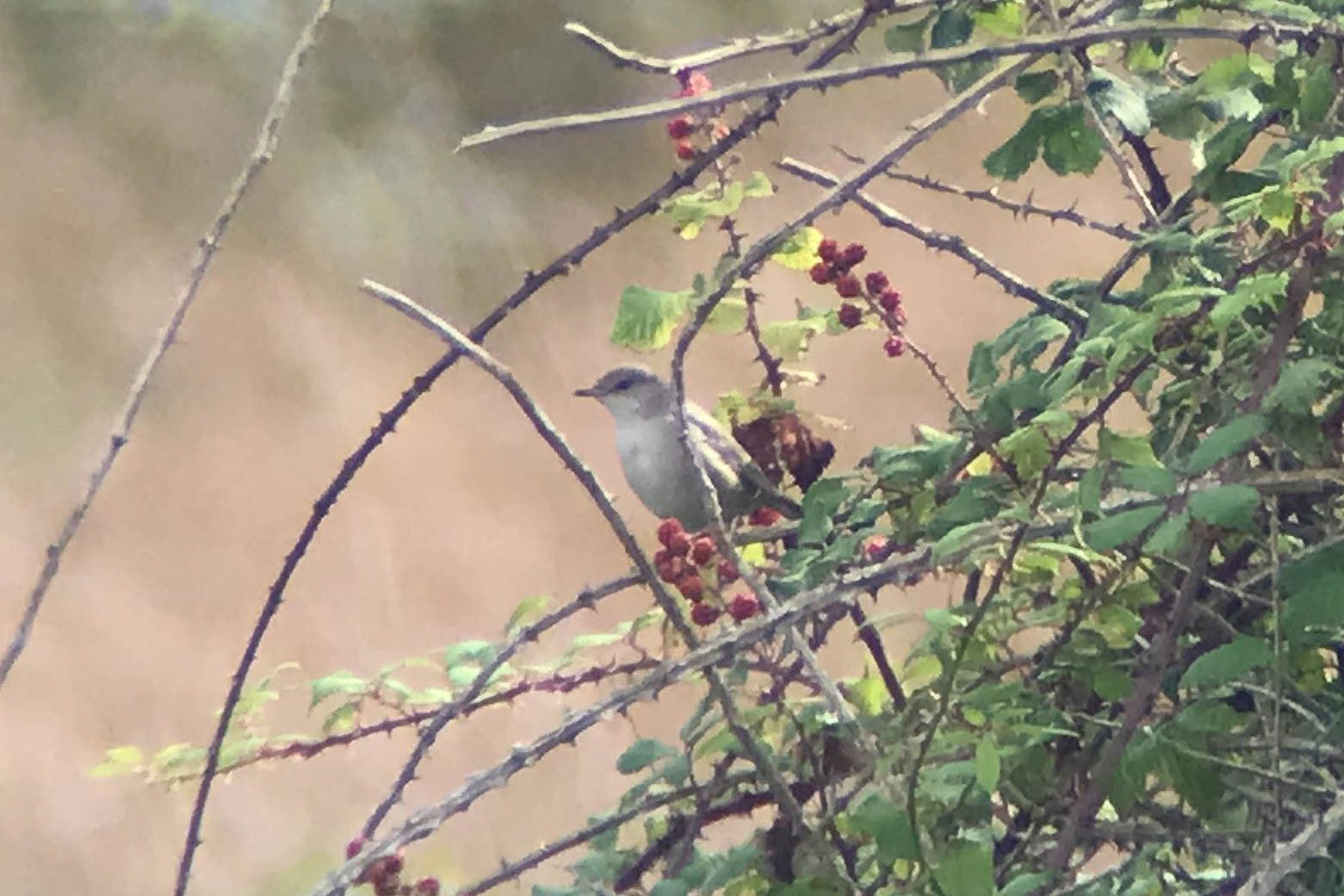
When the Barred Warbler flew out of the bush it was in and disappeared back towards the fence, we decided to walk on. Along the path to the Hard, we stopped to watch several Stonechats in the brambles along the fence. A Common Whitethroat flicked in and out with them. We counted at least 10 Stonechats today, a mixture of mainly one or two adult males and several moulting juveniles. We stopped for a quick scan of the bramble field beyond, but there was no sign of the Wryneck which was here last week. It hasn’t been seen for a couple of days and has presumably gone this time.
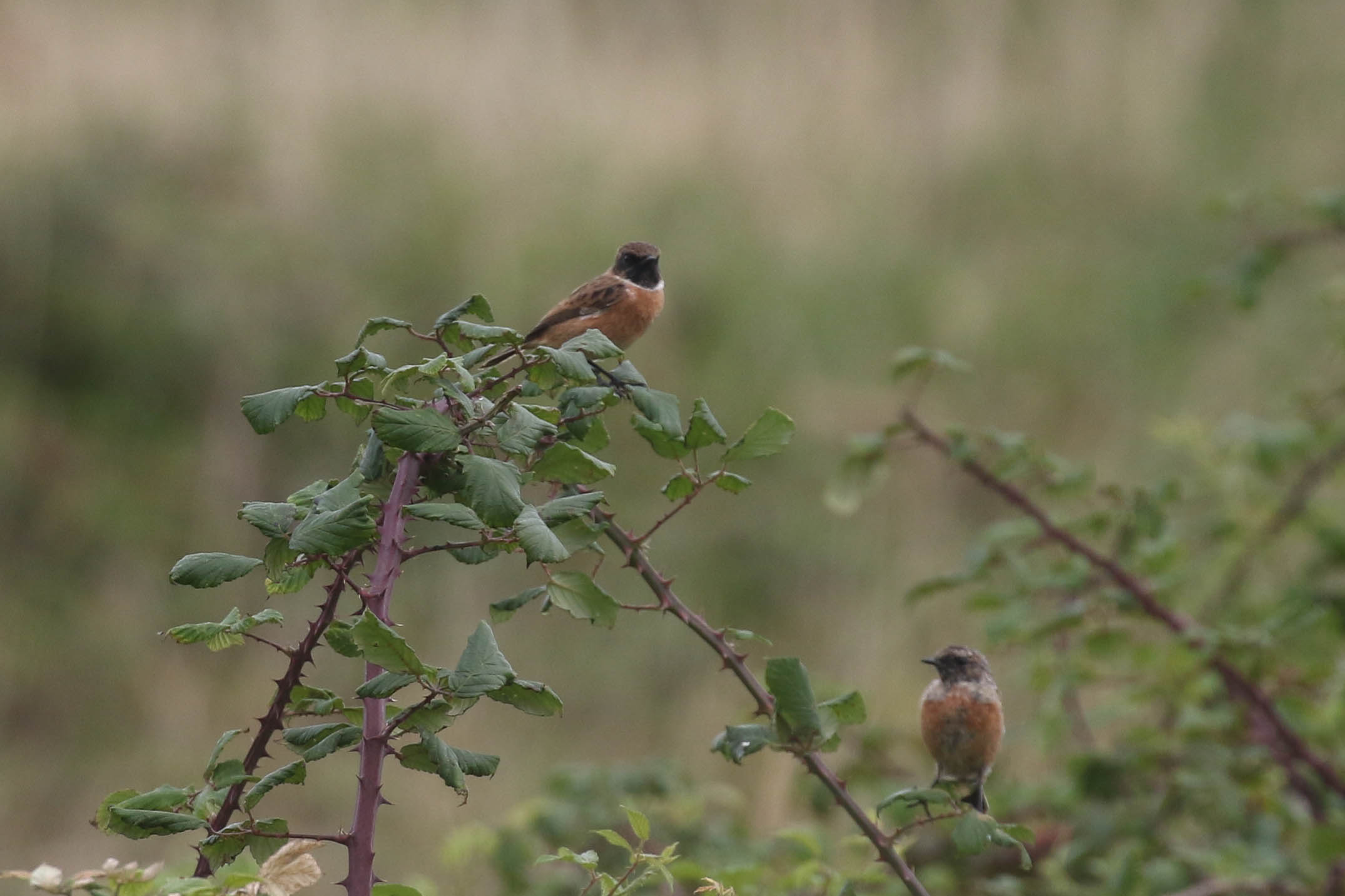
There were lots of Willow Emerald damselflies in the lane today, it seems to be a very good year for them, and the first Wall butterfly of the tour flew past. We walked up the permissive path towards Weybourne Camp but there was no sign of any Wheatears or Whinchats around the gun emplacements today – things can move on quickly. It was clouding over now, and we felt a couple of spits of rain, so we decided to head back just in case.
We stopped for another look at the Barred Warbler, which was back in its original bush again, but it was starting to rain a little harder, so we walked quickly back up the lane. A Sparrowhawk briefly landed in an ash tree ahead of us.
Thankfully the rain was only light, and we were not too wet by the time we got back to the minibus. The rain hadn’t been forecast earlier, but looking at the Met Office weather app now it was suggesting that it could set in for several hours. We drove back round to Cley Coastguards to have a quick look out at the sea from the shelter while we waited to see if it was likely to clear through.
It was nice and dry in the shelter, but quite murky offshore. A Sandwich Tern and a small flock of Cormorants flew past. A lone Knot went west and a single Dunlin east. We only stayed about 15 minutes, and the rain seemed to be getting heavier. It was almost time to finish anyway so we decided to call it a day half an hour early and head back. There was no point getting wet for the sake of it – we would have plenty more time over the next couple of days.
















